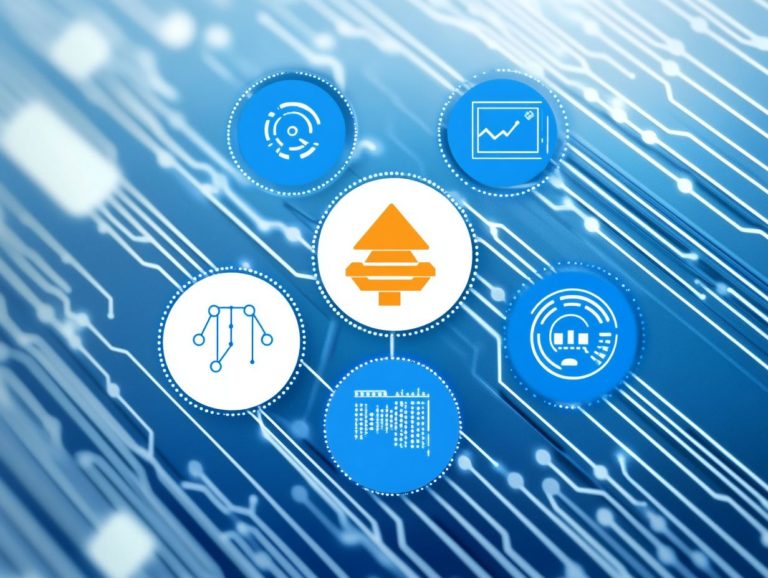PaaS for Education: Transforming Learning
In the rapidly evolving landscape of education technology, you ll find that Platform as a Service (PaaS) stands out as a powerful tool for enhancing learning environments. This article delves into how PaaS empowers educational institutions to streamline operations, boost student engagement, and cultivate innovation.
You ll explore its myriad benefits ranging from cost savings to enriched learning experiences while also uncovering real-world success stories that highlight its impact.
We ll guide you through the steps to implement PaaS effectively, addressing potential challenges along the way. We will also look at future trends that could shape education.
Jump in and see how PaaS can transform your learning journey!
Contents
- Key Takeaways:
- What is PaaS and How Can It Help Education?
- Benefits of PaaS in Education
- Implementing PaaS in Educational Institutions
- Case Studies: Examples of PaaS in Education
- Challenges and Considerations for PaaS in Education
- The Future of PaaS in Education
- Frequently Asked Questions
- 1. What is PaaS for Education and how does it transform learning?
- 2. How does PaaS for Education benefit educational institutions?
- 3. Can PaaS for Education be customized to meet the specific needs of an institution?
- 4. How does PaaS for Education ensure data security and privacy?
- 5. What types of learning applications can be developed using PaaS for Education?
- 6. How can PaaS for Education improve the learning experience for students?
Key Takeaways:

PaaS is a cloud-based platform that enables educational institutions to enhance the learning experience for students through efficient and cost-effective solutions.
By adopting PaaS, educational institutions can save money and improve overall efficiency, resulting in a more seamless and effective learning process.
Successful implementation of PaaS requires careful planning and consideration of potential challenges, but the future of PaaS in education looks promising with continuous advancements and innovations.
What is PaaS and How Can It Help Education?
Platform as a Service (PaaS) offers a new way to cloud computing, providing a robust platform that allows you to develop, run, and manage applications without the hassle of building and maintaining the complex infrastructure typically required for app development and launch.
In the ever-evolving landscape of educational technology, PaaS is essential. It simplifies the creation of dynamic Learning Management Systems (LMS), which help manage educational courses and training. This enables you and your institution to concentrate on what truly matters content and pedagogy while the underlying infrastructure is managed effortlessly.
Take, for instance, tools like Google Classroom and Moodle. They utilize PaaS to elevate user experience and streamline course administration. The integration of AI-powered tutors within these platforms transforms learning environments by delivering personalized feedback and support, paving the way for interactive and adaptive educational experiences.
These innovations illustrate how PaaS not only facilitates the development and deployment of essential digital resources but also revolutionizes modern education.
Benefits of PaaS in Education
The benefits of Platform as a Service (PaaS) in education are truly transformative. Enhanced learning experiences cater to diverse needs while offering considerable cost savings for educational institutions.
By leveraging PaaS, you gain access to efficient solutions that are essential for thriving in today s modern digital learning environments.
Enhanced Learning Experience
PaaS elevates your learning experience by offering tools that allow you to craft interactive lessons, engaging students through elements of gamification and rich multimedia. This platform gives the power to design personalized learning paths that cater to the unique needs and preferences of each student.
By leveraging adaptive assessments and analytics, you can identify specific areas where individual learners may face challenges, enabling you to implement targeted interventions.
A variety of educational institutions, ranging from K-12 to universities, are tapping into these powerful features to create dynamic virtual classrooms that foster collaboration and creativity.
These institutions are seamlessly integrating tools for feedback and communication, ensuring that students remain motivated and actively engaged throughout their educational journeys.
The outcome is a more inclusive and effective learning environment that promotes significant academic growth.
Cost Savings and Efficiency

One of the most compelling reasons for you to adopt Platform as a Service (PaaS), a cloud service model that lets you run applications without managing the underlying infrastructure, in education is its ability to provide cost-effective learning solutions. These solutions streamline administrative tasks and enhance operational efficiency.
By eliminating the need for extensive IT infrastructure, you can allocate your resources more effectively. This shift gives you the power to focus on enriching your curricula and engaging students, rather than getting bogged down with the upkeep of expensive server farms or hardware.
You can take advantage of scalable resources as demands fluctuate, especially during peak enrollment periods or when adapting to new teaching methodologies.
For instance, a university that embraces PaaS may experience significant cost savings in maintenance and operations. This allows those funds to be redirected towards innovative educational programs and improved student support services.
The investment potential of PaaS is exciting and full of possibilities! It not only reduces overhead costs but also cultivates an agile learning environment that can adapt to your evolving needs.
Implementing PaaS in Educational Institutions
Successfully implementing PaaS in educational institutions requires you to adopt a meticulously crafted strategy. This strategy should focus on moving to the cloud, ensuring that both the infrastructure and applications align with your institution’s educational objectives.
Steps to Successfully Adopt PaaS
Adopting PaaS in educational settings demands a structured approach. Start with the selection of reliable cloud service providers and place a strong emphasis on training for educators to fully harness the benefits of these innovative tools.
This journey begins with a comprehensive assessment of your institution’s needs. Ensure that the chosen platform aligns seamlessly with your educational goals and existing infrastructure.
Engaging stakeholders to gather insights from educators is essential. This helps in pinpointing specific requirements and potential challenges.
After this analysis, selecting the right vendor becomes imperative. Evaluate service providers based on their security features, scalability, and support services.
Once PaaS is in place, ongoing training is essential to equip educators with the skills they need to navigate the new software effectively. Providing continuous professional development opportunities, along with regular feedback loops, allows you to assess the platform s impact on teaching and learning outcomes.
This cultivates a culture of improvement and adaptability.
Case Studies: Examples of PaaS in Education
Exploring case studies of educational institutions that have adeptly implemented PaaS offers you invaluable insights into the tangible benefits and challenges of utilizing cloud-based solutions in real-world contexts.
Real-World Applications and Success Stories
Real-world applications of PaaS reveal how educational institutions capitalize on this technology to foster collaboration and enhance student engagement.
Consider a prominent university that has expertly harnessed PaaS tools to create a collaborative platform. This platform enables students to work on group projects seamlessly, even from remote locations.
This platform facilitates file sharing, real-time feedback, and communication, making it easier for students to engage with their peers and instructors.
In the realm of online learning, AI-powered tutors have been integrated through PaaS. This allows for personalized tutoring experiences that adapt to each student’s unique learning pace.
Ultimately, these cutting-edge applications not only streamline administrative processes but also contribute to improved educational outcomes. Students receive a more enriched and fulfilling learning experience!
Challenges and Considerations for PaaS in Education

The adoption of PaaS in education brings a wealth of advantages. However, it also introduces certain challenges and considerations that you must navigate to ensure successful implementation.
Are you ready to transform your educational institution with innovative PaaS solutions? Discover how PaaS can revolutionize your educational experience today!
Potential Roadblocks and How to Overcome Them
When adopting PaaS (Platform as a Service), educational institutions may face several roadblocks, such as data management challenges, inadequate training, and staff resistance to change.
To effectively navigate these hurdles, you can implement targeted training programs tailored to various proficiency levels within your staff. This ensures that everyone is equipped with the skills needed to use the new platform effectively.
Clear communication channels are crucial. Open dialogues about PaaS benefits can ease fears about the transition.
Providing ongoing support and resources for your staff encourages a flexible attitude, gradually diminishing resistance over time. Embracing these strategies helps educational institutions transition to PaaS smoothly. This ultimately enhances their operational efficiency.
The Future of PaaS in Education
Exciting opportunities await with the future of PaaS in education! Emerging trends and cutting-edge learning tools are ready to transform how educational institutions deliver and manage their programs.
Don’t miss out on these groundbreaking changes that will transform your educational experience, fostering a more dynamic and efficient learning environment.
Trends and Predictions for PaaS in the Education Sector
Trends and predictions for PaaS in the education sector suggest a significant uptick in cloud adoption, enhanced data management capabilities, and a heightened focus on personalized learning experiences.
As you navigate the landscape of educational institutions, it s clear they are increasingly recognizing the necessity of agility and scalability in their operations, leading to a robust shift towards PaaS for streamlining their processes.
This transition not only facilitates the seamless integration of various educational tools but also gives the power to educators like you to craft custom applications tailored to meet diverse student needs.
The emergence of advanced analytics in this realm enables institutions to extract valuable insights from student data, fostering a culture of data-driven decision-making.
Looking ahead, you can anticipate future developments that may integrate artificial intelligence and machine learning into PaaS platforms, paving the way for adaptive learning environments that progressively cater to individual learning styles.
Frequently Asked Questions
1. What is PaaS for Education and how does it transform learning?

PaaS (Platform as a Service) for Education is a cloud computing service that provides a platform for educational institutions to develop, manage, and deliver learning applications and services. This technology transforms learning by providing a flexible, scalable, and cost-effective solution for delivering educational content and resources to students.
2. How does PaaS for Education benefit educational institutions?
PaaS for Education offers a range of benefits for educational institutions, including reduced infrastructure costs, simplified application development and deployment, improved collaboration and communication among students and teachers, and access to a wide range of educational tools and resources.
3. Can PaaS for Education be customized to meet the specific needs of an institution?
Yes, PaaS for Education can be customized to meet the unique needs of each educational institution. This includes customizable features such as branding, security settings, and integration with existing systems.
4. How does PaaS for Education ensure data security and privacy?
PaaS for Education utilizes advanced security measures, such as encryption, access controls, and data backups, to ensure the security and privacy of user data. Additionally, all data is stored in secure, certified data centers, and regular security audits are conducted.
5. What types of learning applications can be developed using PaaS for Education?
PaaS for Education supports a wide range of learning applications, including virtual classrooms, online assessments, interactive learning tools, and student management systems. Additionally, institutions can explore how PaaS in e-commerce can be utilized to develop their own custom applications to meet specific needs.
6. How can PaaS for Education improve the learning experience for students?
PaaS for Education offers a fun and engaging learning experience. With new tools at their fingertips, students can unlock educational materials anytime, anywhere, thanks to SaaS for education that is transforming learning environments!






